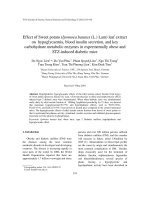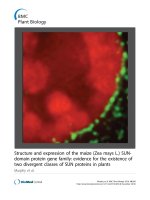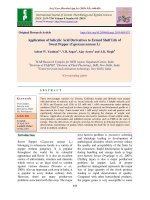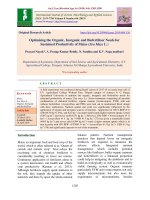Effect of different doses of vanadium on yield attributing characters of sweet corn (Zea mays L.)
Bạn đang xem bản rút gọn của tài liệu. Xem và tải ngay bản đầy đủ của tài liệu tại đây (174.02 KB, 5 trang )
Int.J.Curr.Microbiol.App.Sci (2018) 7(8): 3097-3101
International Journal of Current Microbiology and Applied Sciences
ISSN: 2319-7706 Volume 7 Number 08 (2018)
Journal homepage:
Original Research Article
/>
Effect of Different Doses of Vanadium on Yield Attributing
Characters of Sweet Corn (Zea mays L.)
Akshay S. Magar1, Pragati Misra2, M.B. Latke3,
Pradeep Kumar Shukla1* and P.W. Ramteke1
1
Department of Biological Sciences, Faculty of Science, Sam Higginbottom University of
Agriculture, Technology and Sciences, Allahabad 211007, UP, India
2
Department of Molecular and Cellular Engineering, Jacob School of Biotechnology and
Bioengineering, Sam Higginbottom University of Agriculture, Technology and Sciences,
Allahabad 211007, UP, India
3
Department of Genetics and Plant Breeding, Naini Agriculture Institute, Sam Higginbottom
University of Agriculture, Technology and Sciences, Allahabad 211007, UP, India
*Corresponding author
ABSTRACT
Keywords
Vanadium, Sweet corn,
Growth, Yield characters
Article Info
Accepted:
17 July 2018
Available Online:
10 August 2018
A pot experiment was conducted in the Department of Biological Sciences at SHUATS
Allahabad during rabi session 2017-2018 to study the effect of different concentration of
vanadium (0, 20ppm, 40ppm, 60ppm, 80ppm, 100ppm) on two variety of sweet corn (Zea
mays L.) Madhuri & PhuleMadhu. Vanadium was applied mode of application at 30 DAS
and flowering time. The observation was recorded at harvesting time. It was shows that
maximum production observed in variety Madhuri in T 2 (20 ppm) compared to control.
Minimum production shows variety Phule Mahu (100ppm) compared to control.
Vanadium applied to plant in low concentrate resulted in improvement of yield of sweet
corn.
Introduction
Sweet corn (Zea mays L.) is the world’s most
widely cultivated food crop. It is a member of
family Gramineae (Poaeceae) sub family
Panicoideae. Maize is known as ‘Queen of
cereals’ and ‘King of fodder’. Sweet corn is a
hybridized variety of maize specifically breeds
to increase the sugar content. Its consumption
at immature stage as roasted and boiled ears is
a popular practice as the kernels are sweet
(content 12–20% sugar), creamy, tender and
crispy. After harvesting green cobs, the plants
of sweet corn are used as green fresh or dry
fodder. This speciality corn with its high
market value is gaining popularity and now a
day’s its cultivation is the first choice of the
farmers (Suthar et al., 2014).
Sweet corn is a new choice of the progressive
farmers as its green cobs as well as nutritious
green fodder fetch higher market prices
(Painyuli et al., 2013). It is gaining popularity
both in rural and urban areas because of its
3097
Int.J.Curr.Microbiol.App.Sci (2018) 7(8): 3097-3101
higher sugar and low starch content
and delicious (Singh et al., 2012). Corn is one
of the most important food resources of
human and as a C4 crop absorbs high amounts
of nutrients from the soil. The important
feature of this plant’s growth is efficiency of
micro elements in various conditions of soils
(Safyan, 2012).
Micronutrients play an active role in the plant
metabolism process starting from cell wall
development to respiration, photosynthesis,
chlorophyll formation, enzyme activity
nitrogen fixation and reduction (Adhikary et
al., 2010). Vanadium (V) is a transition
element widely distributed in nature and
biological systems, as well as a part of fossil
fuels, and agricultural supplies, such as
chemical fertilizers which contain ammonium
metavanadate (NH4VO3) (Hector et al., 2017).
V is the 5th most abundant element among the
transitional metals in the earth crust. V is
extensively dispersed in the environment by
different ways like leaching, combustion, use
of fertilizers, and waste material from
industries, resultantly; V contaminates the
soil, water and atmosphere. The most common
form of vanadium is Vanadium pentaoxide
(V2O5), followed by ammonium metavanadate
(NH4VO3)
and
sodium
orthovanadate
(NaH2PO4) (Imtiaz et al., 2014). Vanadium is
also essential for several species of fungi and
nitrogen-fixing microorganisms but there is
little evidence whether it is essential for higher
plants (Saco et al., 2013).
The role of vanadium in plants is very
important during proper growth and
development of plants, on the other hand there
are many recent reports, which demonstrate
the essentiality of V for plants growth and
metabolism (Vachirapatama et al., 2011).
However, the adoption of improved
agronomic practices, suitable varieties
(Madhuri & PhuleMadhu) and suitable dose of
vanadium can increase crop productivity.
Ultimately growing suitable varieties with
proper dose of vanadium increase growth and
yield of crop. Therefore the objectives effect
of Vanadium on yield of sweet corn.
Materials and Methods
The present experiment was undertaken at
field of Department of Biological Sciences,
Naini Agriculture Institute, Sam Higginbottom
University of Agriculture, Technology and
Sciences Allahabad, Uttar Pradesh, India
during Rabi 2017-18. Sweet corn seeds of
hybrid Madhuri and Phulemadhu were used
for the pot experiment. Pot experiment was
done according to completely randomized
design
with
three
replications,
and
recommended package of practices were
followed to raise the crop. Approximately 8 kg
of soil was filled in pot and sowing was done
using 3-4 seed per pot by dibbling method.
The observation were recorded on each plants
of each pot and replication for Number of cob
per plant, Cob length (cm), Cob girth (cm),
Green cob weight (g/ plant). Sweet corn (30
DAS and flowering time) were allowed to
apply Vanadium solution containing seven
different Ammonium metavanadate (NH4VO3)
concentration: 0, RDF, 20, 40, 60, 80, 100
PPM. The Vanadium solution were
maintained a constant volume during the pot
experiment. Analysis of variance (ANOVA)
as suggested Fisher and Yates (1936) was
used to determine the statistical significant of
the difference between treatment means in all
experiments.
Results and Discussion
The result in the table 1 indicate that the effect
of different concentration of vanadium on
same important parameters viz. Number of
cob per plant, cob length (cm), cob girth (cm),
Green cob weight (g/ plant) in two varieties of
sweet corn Madhuri and PhuleMadhu.
3098
Int.J.Curr.Microbiol.App.Sci (2018) 7(8): 3097-3101
Table.1 Analysis of variance for yield characters of sweet corn
Sr.
No
1
2
3
4
Characters
Mean Sum of Squares
Treatments (df=7)
Error (df=21)
V1
V2
V1
V2
0.20**
0.42**
0.09
0.04
69.18**
8.33**
12.33
0.14
40.15**
2688**
0.56
0.51
914.23**
1363**
24.03
3.22
Number of cobs
Cob length (cm)
Cob Girth (cm)
Green Cob weight (g/plant-1)
** Significant at 1% Level
Table.2 Mean table of yield character of sweet corn Madhuri
Treatment
Control
RDF
RDF+V(20 ppm)
RDF+V(40ppm)
RDF+V(60ppm)
RDF+V(80ppm)
RDF+V(100ppm)
Gen. Mean
MIN.
MAX.
C.V.
S.E.M.
C.D. 5%
Number of
Cobs/Plant
1.00
1.00
2.00
1.33
1.00
1.00
1.00
1.19
1.00
2.00
18.33
0.13
0.38
Cob Length (cm)
15.23
16.57
20.33
18.90
18.03
17.27
16.87
17.60
15.23
20.33
2.13
0.22
0.66
Cob Girth (cm)
7.23
10.40
16.13
14.87
13.87
12.80
11.53
12.40
7.23
16.13
5.80
0.42
1.26
Green Cob Weight
(gm/plant)
47.43
62.57
112.57
93.57
90.00
86.80
81.63
82.08
47.43
112.57
2.19
1.04
3.15
Table.3 Mean table of yield character of sweet corn PhuleMadhu
Treatment
Control
RDF
RDF+V(20 ppm)
RDF+V(40ppm)
RDF+V(60ppm)
RDF+V(80ppm)
RDF+V(100ppm)
Gen. Mean
MIN.
MAX
C.V.
S.E.M.
C.D. 5%
Number of Cobs/plant
1.00
1.00
1.67
1.33
1.00
1.00
1.00
1.14
1.00
1.67
27.00
0.18
0.01
3099
Cob Length
(cm)
3.40
8.23
16.47
15.73
14.93
14.30
13.93
12.43
3.40
16.47
28.25
2.03
6.15
Cob Girth
(cm)
2.47
5.17
12.53
11.50
10.60
10.10
9.73
8.87
2.47
12.53
8.45
0.43
1.31
Green Cob Weight
(gm/plant)
2.07
13.77
48.37
45.87
41.27
39.37
31.77
31.78
2.07
48.37
15.43
2.83
8.59
Int.J.Curr.Microbiol.App.Sci (2018) 7(8): 3097-3101
Data presented in table 2 data shows that for
Madhuri variety maximum all parameter was
found in T2 - RDF + Vanadium (20 ppm)
followed by, T3 - RDF + Vanadium (40 ppm),
T4 - RDF + Vanadium (60 ppm), T5- RDF +
Vanadium (80 ppm), T6 - RDF + Vanadium
(100ppm), T1 - RDF and T0 - Control. All
treatments showed significant difference in all
parameters over control. Data presented in
table 3 data shows that for Phulemadhu
variety maximum parameter was found in T2 RDF + Vanadium (20 ppm) followed by T3 RDF + Vanadium (100 ppm), T4 - RDF +
Vanadium (40 ppm), T5 - RDF + Vanadium
(60 ppm), T5 - RDF + Vanadium (80 ppm), T1
- RDF, T0 - Control. All treatments showed
significant difference in all parameters over
control. Similar finding for plant height, no.
leaf, root length, leaf area and yield was
observed by Vachirapatama et al., (2011)
where he found that low concentration of
vanadium increases the plant growth
parameters of chines cabbage and tomato.
This effect may be due to the fact that V at
this concentration can help increase nitrogen
in the form of ammonium compound
activating the rice growth Nalewajko et al.,
(1995). It is also essential for some species of
nitrogen fixing bacteria, algae, and fungi. V
plays a pivotal role in the formation of the
holo-enzyme of peroxidase of bromine,
iodine, and chlorine Hector et al., (2017).
Signifying amount of V in soil water we can
shows to have inhibitory effect on plant some
enzymes, growth & photosynthesis Kasim et
al., (1999). Similar finding was given by, the
obtained result was yield decreases with
increases the rate of vanadium because
toxicity symptom in roots are club shaped,
secondary root number reduction and necrosis
Gil et al., (2008). It is the concluded from
studies, on vanadium 20 ppm was found as
best treatment to increases the yield of sweet
corn in pot experiment. The result of current
study also indicated that the higher dose of
vanadium shows reverse effect on the yield
contributing character of the sweet corn.
References
Adhikary, B. H., Shrestha, J. and RajBaral, B.
(2010). Effects of micronutrietns on
growth and productivity of maize in
acidic
soil.International
Research
Journal of Applied and Basic Sciences,
1(1): 8-15.
Chongkid, B., Vachirapattama, N., and
Jirakiattikul, Y. (2007). Effects of
vanadium on rice growth and vanadium
accumulation in rice tissues kasetsart.
Journal of national Agriculture, 41: 2833.
Gil, J., Alvarez, C.E., Martinez, M.C. and
Pérez, N. (1994).Effect of vanadium on
lettuce growth, cationic nutrition, and
yield.Environmental
science
and
engineering, 30(1): 73-87.
Gul, S., Khan, M. H., Khanday, B. A. and
Nabi, S. (2015). Effect of sowing
methods and npk levels on growth and
yield of rainfed maize (Zea mays L.).
Hindawi
Publishing
Corporation
Scientific Article ID. 198575: (6).
Hector, E., Trejo-Tellez, L. I., Volke-Haller,
V. H., Cadena-Iniguez, J., Garcıa, P. S.
and Gomez-Merino, C. (2017). Iodine,
silicon, and vanadium differentially
affect growth, flowering, and quality
components of stalks. Sugarcane Sugar
Tech, 17-572.
Kasai, M., Yamazak, J.,Kikuchi, M., Iwaya,
M.
and
Sawada,
S.
(1999).
Concentration of vanadium in soil water
and its effect on growth and metabolism
of rye and wheat plants. Journal of
Communications in Soil Science and
Plant Analysis, 30(7-8): 971-982.
Khan, W. and Singh, V. (2017). Response of
phosphorus application on yield, quality
and economics of sweet corn (Zea mays
L. saccharata) varieties. Journal of
3100
Int.J.Curr.Microbiol.App.Sci (2018) 7(8): 3097-3101
Pharmacognosy and phytochemistry.
6(5): 2205-2208.
Meisch, H. U., Benzschawel, H. & Biella, H.
J. (1977).Role of vanadium in green
plants. Journal of Archives of
Microbiology, 116(1): 91-95.
Muhammad, I., Shuxin, T., Zhijian, X., Han,
D., Muhammad, A. and Muhammad S.
(2014).Growth,
V
uptake,
and
antioxidant enzymes responses of
chickpea
(Cicer
arietinum
L.)
genotypes under vanadium stress. Plant
Soil, 10: 14-41.
Nassrin, S., Mohammad, R. N. and Babak, B.
(2012). The effect of microelements
spraying on growth, qualitative and
quantitative grain corn in Iran.
International Research Journal of
Applied and Basic Sciences. 3: 27802784.
Painyuli, A., Pal, M. S., Bhatnagar, A. and
Bisht, A. S. (2013). Effect of planting
techniques and irrigation scheduling on
productivity and water use efficiency of
sweet corn (Zea mays saccharata).
Indian Journal of Agronomy, 58(3):
344-348.
Saco, D., Martín, S. and S. Jose. (2013).
Vanadium distribution in roots and
leaves
of
Phaseolus
vulgaris
morphological
and
ultra-structural
effects. Journal of Biologiaplantarum.
5(1): 128-132.
Singh, U., Saad, A., Chand, T. R., Mir, S. A.
and Aga, F. A. (2012). Productivity,
economics and nitrogen-use efficiency
of sweet corn (Zea mays saccharata.) as
influenced by planting geometry and
nitrogen fertilization. Indian Journal of
Agronomy, 57(1): 43-48.
Suthar, M., Singh, D., Nepalia, V. and Singh
A. K. (2014). Performance of sweet
corn (Zea mays) varieties under varying
fertility levels. Indian Journal of
Agronomy, 59(1): 168-170.
Teng, Y., Yang, J., Sun, Z., Wang, J., Zuo, R.
and Zheng, J. (2011). Environmental
vanadium distribution, mobility and
bioaccumulation in different land-use
Districts in Panzhihua Region, SW
China. Environment Monit Assess, 176:
605-620.
How to cite this article:
Akshay S. Magar, Pragati Misra, M.B. Latke, Pradeep Kumar Shukla and Ramteke, P.W. 2018.
Effect of Different Doses of Vanadium on Yield Attributing Characters of Sweet Corn (Zea
mays L.). Int.J.Curr.Microbiol.App.Sci. 7(08): 3097-3101.
doi: />
3101









